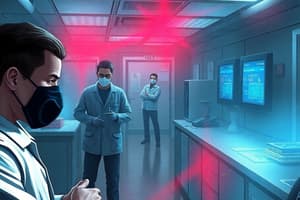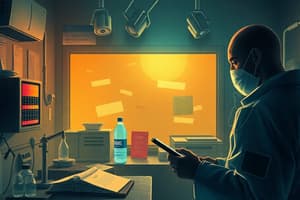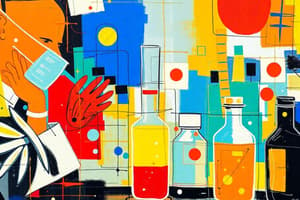Podcast
Questions and Answers
Which unit in a crime lab is responsible for examining body fluids and organs to detect drugs and poisons?
Which unit in a crime lab is responsible for examining body fluids and organs to detect drugs and poisons?
- Toxicology Unit (correct)
- Firearms Unit
- Biology Unit
- Latent Fingerprint Unit
In the context of forensic science, what is the primary purpose of a 'comparison' analysis?
In the context of forensic science, what is the primary purpose of a 'comparison' analysis?
- To link a suspect's evidence with a reference sample to see if they share a common origin. (correct)
- To establish the exact age of a piece of evidence.
- To determine the chemical identity of a substance.
- To identify all possible substances found at a crime scene.
Which legal case established that forensic scientists must appear in court to testify about their findings?
Which legal case established that forensic scientists must appear in court to testify about their findings?
- Frye v. United States
- Melendez-Diaz v. Massachusetts (correct)
- Daubert v. Merrell Dow Pharmaceuticals
- Crawford v. Washington
What is the main purpose of using Personal Protective Equipment (PPE) during evidence collection at a crime scene?
What is the main purpose of using Personal Protective Equipment (PPE) during evidence collection at a crime scene?
What is the significance of the Frye Standard in the context of forensic evidence admissibility in court?
What is the significance of the Frye Standard in the context of forensic evidence admissibility in court?
Which of the following best describes the role of the Physical Science Unit in a crime lab?
Which of the following best describes the role of the Physical Science Unit in a crime lab?
Why is maintaining a chain of custody crucial in forensic science?
Why is maintaining a chain of custody crucial in forensic science?
Which search pattern involves two investigators conducting overlapping searches in a perpendicular manner?
Which search pattern involves two investigators conducting overlapping searches in a perpendicular manner?
What type of evidence is best suited for storage in paper bags or envelopes to prevent moisture buildup?
What type of evidence is best suited for storage in paper bags or envelopes to prevent moisture buildup?
In the context of crime scene investigation, what is meant by 'securing the scene'?
In the context of crime scene investigation, what is meant by 'securing the scene'?
Flashcards
FBI Crime Lab
FBI Crime Lab
Maintains the largest crime lab globally with broad investigative powers.
Physical Science Unit
Physical Science Unit
Uses physics, geology, and chemistry to analyze evidence like soil, glass, and chemicals.
Document Unit
Document Unit
Handles handwriting analysis and investigates questioned documents like checks and wills.
Toxicology Unit
Toxicology Unit
Signup and view all the flashcards
Frye Standard
Frye Standard
Signup and view all the flashcards
Daubert Standard
Daubert Standard
Signup and view all the flashcards
Packaging Evidence
Packaging Evidence
Signup and view all the flashcards
Chain of Custody
Chain of Custody
Signup and view all the flashcards
Identification
Identification
Signup and view all the flashcards
Comparison Analysis
Comparison Analysis
Signup and view all the flashcards
Study Notes
Crime Labs and Their Roles
- Rapid expansion of U.S. crime labs is occurring with the increased number of drug cases and unanalyzed rape kits.
Federal Crime Labs
- FBI maintains the largest crime lab, with broad investigative powers.
- DEA analyzes seized drugs.
- ATF focuses on alcohol, tobacco, firearms, and explosives.
- The U.S. Postal Service investigates crimes associated with mail.
State and Local Crime Labs
- Operate under central state authority and provide forensic services to the majority of areas within the state.
- Serve county and city agencies, often locally government funded.
Basic Crime Lab Units
- Physical Science Unit: Uses principles of physics, geology, and chemistry to identify and compare evidence such as soil, glass, or chemicals.
- Biology Unit: Investigates biological evidence including body fluids, hair, and fibers.
- Document Unit: Handles handwriting analysis and examines questioned documents like checks and wills.
- Photography Unit: Records and examines physical evidence through photography and documents crime scenes.
- Firearm Unit: Investigates bullets, cartridge cases, shotgun shells, and ammunition.
- Toxicology Unit: Examines body fluids and organs for drugs or poisons.
- Latent Fingerprint Unit: Processes and analyzes latent fingerprints.
- Polygraph Unit: Conducts lie detector tests for investigations.
Forensic Scientists
- Apply scientific principles to analyze evidence during criminal investigations and provide expert testimony in court.
Scientific Method
- A question is formulated that is important for the investigation.
- A hypothesis is created that answers the question.
- Experiments are done to test the hypothesis.
- If testing validates a hypothesis, this becomes evidence.
Legal Precedents and Courtroom Cases
- Crawford v. Washington addresses a defendant's right to confront witnesses per the Sixth Amendment.
- Melendez-Díaz v. Massachusetts requires forensic scientists to testify in court.
- Scientific evidence must be generally accepted by the established community to be admissible in court, per Frye v. United States.
- Daubert v. Merrell Dow Pharmaceuticals establishes guidelines for judges regarding scientific evidence admissibility
Daubert Guidelines
- Testing: Has the theory been tested?
- Peer Review: Has it been published and reviewed?
- Error Rate: Does it have a known error rate?
- Standards: Are there standards controlling the procedure?
- Acceptance: Is the method widely accepted?
Evidence Collection
- Evidence Technicians/CSI personnel are on-call to collect evidence and ensure proper processing.
- A crime scene must be secured with crime tape and boundaries, and a walkthrough is conducted to locate entry/exit points and evidence.
Search Patterns
- Line/Strip Search: Investigators follow straight, parallel lines.
- Grid Search: Investigators conduct an overlapping search pattern.
- Spiral Search: Search is in a spiral, from the center outwards.
Evidence Collection
- Proper packaging is critical to prevent contamination by using separate containers, manila envelopes, or pill boxes.
- Biological materials should be air-dried and stored in paper envelopes.
Chain of Custody
- A record of everyone who has handled the evidence and where it has been, ensuring evidence remains untampered and admissible
- Evidence labelled, marked, and logged in evidence submission forms.
Contamination Prevention
- Coughing, sneezing, or improper handling introduces materials onto evidence, and PPE (latex gloves/facemasks) and disposable equipment reduces this risk.
Amanda Knox Case
- Amanda Knox was wrongfully convicted of the murder of Meredith Kercher in Italy.
- Forensic evidence mainly pointed to Rudy Guede, who had fingerprints in Kercher's bedroom
- The media sensationalized Knox's personal life, portraying her negatively.
- Her initial conviction was overturned by the Italian Supreme Court due to insufficient forensic evidence.
Types of Physical Evidence
- Blood evidence helps determine if a crime has occurred.
- Hair and fibers are trace evidence linking people to a scene.
- Semen is often found in assaults.
- Documents includes checks, letters, or other written items as evidence.
- Drugs and explosives are evidence in drug-related/terrorist crimes.
- Paint, plastic, and rubber are often linked to vehicle incidents.
- Firearms and Ammunition are used for ballistic matching.
Identification vs. Comparison
- Identification determines the identity of a substance (e.g., identifying a drug).
- Comparison determines if a suspect sample and a reference sample share a common origin.
Classes vs. Individual Characteristics
- Class Characteristics: Linked to a group (fibers/paint from a source).
- Individual Characteristics: Traced to an individual (fingerprints, DNA).
Forensic Databases
- IAFIS: Fingerprint and criminal history information.
- CODIS: DNA profiles for comparison.
- NIBIN: Ballistics evidence from firearms.
- PDQ: Chemical data for automobile paint.
Key Figures
- Bertillon: Devised a system for personal identification using body measurements.
- Galton: Developed the first statistical study proving the uniqueness of fingerprints.
- Lattes: Devised the first procedure for typing dried bloodstains.
- Goddard: Made the comparison microscope an indispensable tool of firearms examination.
- Osborn: Applied scientific principles to document examination.
- Gross: Advocated for the application of science to criminal investigation.
- Locard: Suggested that the transfer of evidence occurs when two objects come in contact with one another (Locard's Exchange Principle).
History
- The first functional crime lab was in Lyons, France, under Edmond Locard.
- The first forensic laboratory in the United States was created in 1923 by the Los Angeles Police Department.
- A system of integrated, regional and satellite laboratories operates in the state of California.
- Britain's crime laboratory system is characterized by a national system of government-funded laboratories
- Increased demand for DNA analyses has been the single most important factor in expanding crime laboratory services in the United States
Federal Agencies
- The FBI, DEA, ATF, and the U.S. Postal Inspection Service all offer important services related to forensic science
- A decentralized system of crime laboratories exists in the United States under various governmental agencies at the federal, state, county, and municipal levels.
Crime Lab Functions
- The physical science unit identifies and compares crime-scene evidence by using chemistry, physics, and geology.
- The biology unit examines blood, hairs, fibers, and botanical materials
- The firearms unit investigates bullets, cartridge cases, shotgun shells, and ammunition.
- The toxicology unit examines body fluids and organs for drugs and poisons.
- The crime scene investigation unit dispatches trained personnel to retrieve evidence.
- The "general acceptance" principle as a criterion for the judicial admissibility of scientific evidence was set forth in Frye v. United States.
- Regarding assessment of admissibility of new/unique scientific tests, the trial judge does not need to rely solely on "general acceptance", per Daubert v. Merrell Dow Pharmaceuticals, Inc.
- An expert witness can demonstrate a skill or knowledge in a trade or profession that helps the court determine the matter at issue.
- U.S. Supreme Court addressed issues relating to the Confrontation Clause of the Sixth Amendment in the case of Crawford v. Washington
- The expert witness's courtroom demeanor may play an important role in deciding what weight the court assigns to their testimony.
- Personal opinion counts as testimony from an expert witness if they studied or examined a case.
Procedures
- Drug Unit tests for controlled substances
- Biology Unit analyzes blood type, DNA, etc. on bloodstained shirts
- Firearms Unit matches bullet casings shot from a scene to weapons and determine caliber
- Document Examination Unit analyzes writing and can check the authenticity of documents like a check.
- Toxicology Unit tests a vial of bodily fluids for drugs, alcohol, or poisons.
- Latent Fingerprinting uses the AFIS databases to determine the identidy of unknown prints found at the scene
- Anhtropology Unit can help in forensic science by being able to identify if human remains exist and may be able to dtermine the trauma
- Soil samples or strands of hair may be found at the scene to find the cause with the crime scene and what may have taken plave
Studying That Suits You
Use AI to generate personalized quizzes and flashcards to suit your learning preferences.




